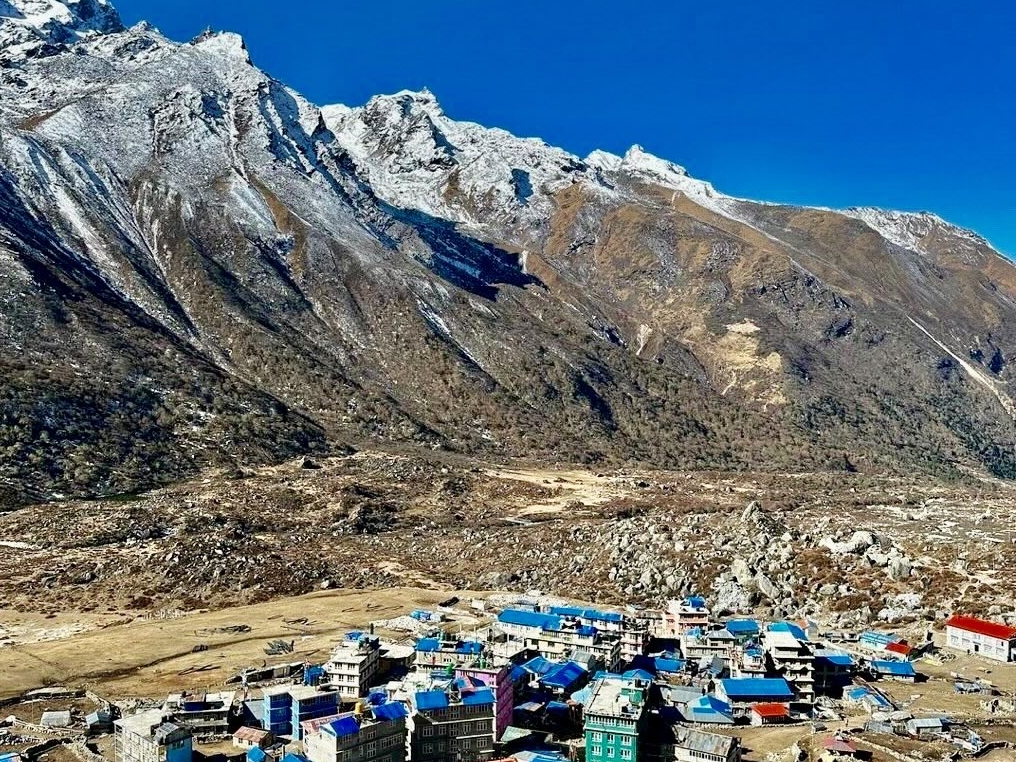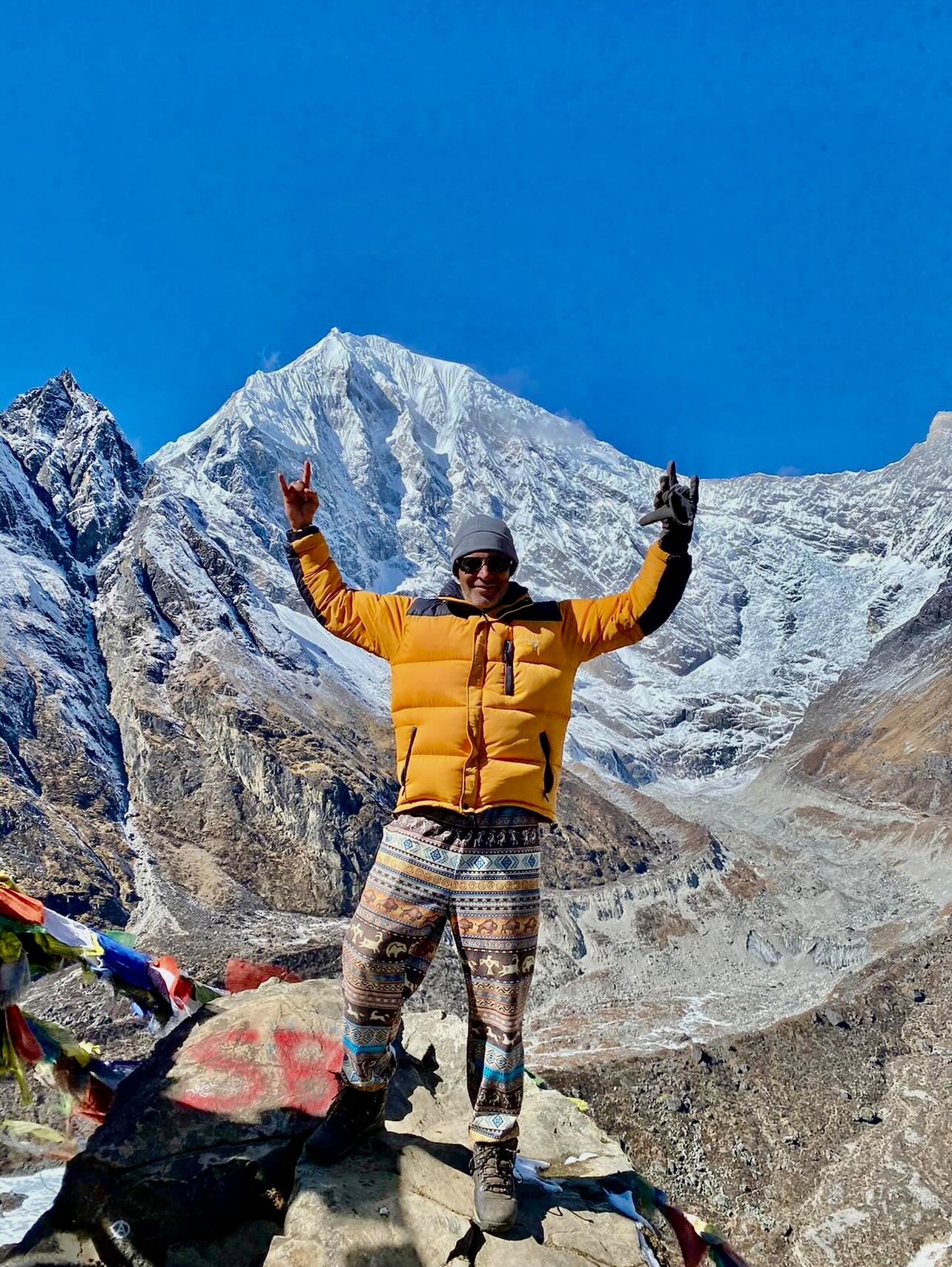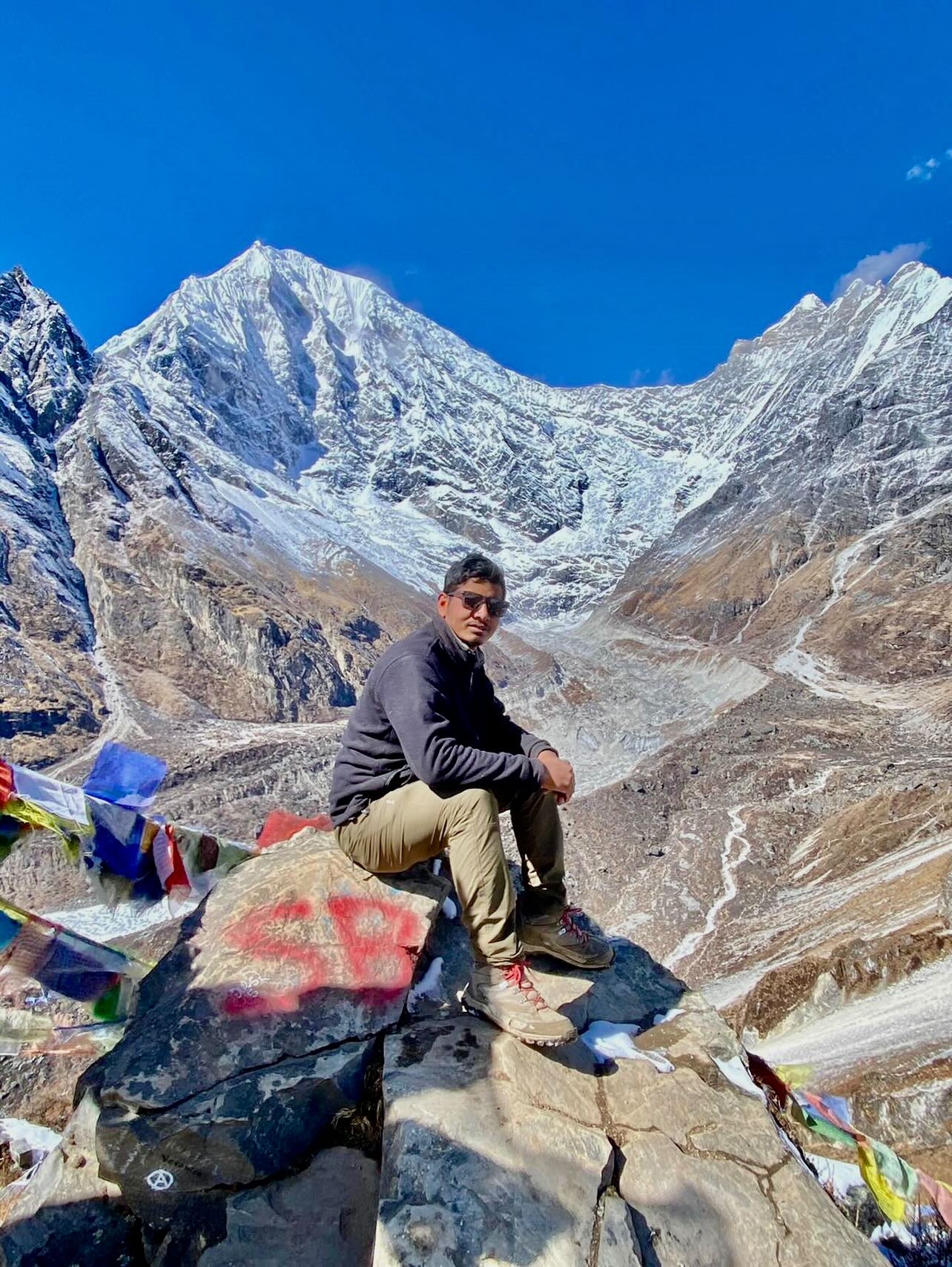
The Langtang Valley Trek stands as an easily accessible trekking destination in the Rasuwa district of Nepal, offering a captivating experience for both the eyes and the soul. The panoramic views of the Langtang ranges, accompanied by the majestic Dhambu, Therpa Che, Kim Chong, and Tsergo Ri mountains, make this journey truly breathtaking. Beyond the natural allure, Langtang boasts a unique culture and livelihood, making it an unparalleled destination for trekking enthusiasts.
For those seeking a trekking adventure with spectacular Himalayan vistas, Langtang emerges as the optimal choice, allowing trekkers to ascend as high as 4700 meters above sea level while immersing themselves in the rich Himalayan culture. So, why not visit Langtang Valley, trek up to 4700m, and soak in the beauty and culture of the Himalayas?
The name "Langtang" originates from the local language, signifying a place where an ox was found. In the distant past, the people of Langtang imported an ox from Tibet for religious purposes. However, the ox went missing, leading to a quest that eventually unveiled the creature in the Himalayas, giving birth to the name "Langtang."
Situated in the Rasuwa District of the Bagmati province in Nepal, Langtang Valley is within a day's drive from Kathmandu. This proximity makes Syabrubesi, the starting point of the Langtang trek, easily accessible. Annually, numerous domestic and international tourists are drawn to this locale, offering an opportunity to immerse in hilly culture and beauty, ultimately reaching the lap of the Himalayas.
This article offers comprehensive details about the Langtang Valley trekking experience, shedding light on both the scenic beauty and the poignant history of the Langtang Valley. It delves into the impact of the 2015 earthquake, which resulted in devastating landslides, and provides insights into the mesmerizing views and the trekking trail.
For a detailed itinerary for Langtang Valley Trekking please click the link below:
https://treklanders.com/trips/langtang-valley-trek
The journey from Kathmandu to Syabrubesi marks the commencement of the Langtang trek. A private jeep takes trekkers on a 6-hour drive through the Prithivi Highway, reaching an elevation of around 1450 meters above sea level. The trek officially kicks off the following day after a night's stay in Syabrubesi.
On day 2, we will head towards Langtang Valley, and our day will halt for lunch at Bamboo. Our trek commences with a delicious breakfast, sparking curiosity with diverse flavors. From the initial day of your Langtang Valley trek, the river accompanies you, akin to a faithful friend. After traversing the road for a while, you will encounter a crumbling suspension bridge, reaching a place named Domen after an hour. The primary distinction between trekking and other journeys lies in slow on foot, providing us the opportunity to be close to nature. Trekking unveils sights that are often overlooked in other modes of travel. Ascending inclines intensify respiration, creating a rhythmic cadence in sync with the breath. The trekker, amidst this journey, perceives the enchanting melodies of birds, engages in conversations with the flowing river, and finds moments of reflection on life.
After approximately 3 to 4 hours of walking, we will arrive at Bamboo, where we will indulge in a delightful lunch. Post-lunch, we continue our trek for another 3 hours, reaching Lama Hotel—a designated resting place for the day. En route to Lama Hotel, we encounter a place called Rimche, walking along the river that has been our companion since the trek's initiation.
The refreshing coolness of the river water offers relief to bodies fatigued by the day's heat. As Rimche approaches, a challenging road with a landslide must be traversed, with rocks intermittently falling. After a brief rest in Rimche, our journey resumes towards Lama Hotel. Reveling in the scenic beauty along the path, you will arrive at Lama Hotel approximately 15 minutes from Rimche.
We will spend the night at Lama Hotel, situated at an altitude of 2500 meters above sea level, offering splendid views nestled among the hills. While mountains may not be visible from Lama Hotel, anticipation builds as we ascend, promising breathtaking views. Prepare for tomorrow and enjoy a restful night's sleep.
Unlike the hustle and bustle of cities like Kathmandu, Lama Hotel embraces a profound serenity in the morning. The melodious chirping of birds and the gentle murmur of the flowing river enhance the beauty of the morning. Following breakfast, we set forth towards Langtang Valley. Initially, walking may feel discomfort, but as you continue, your body gradually acclimatizes, making the journey more comfortable.
In the realm of trekking, the appearance of destinations and the time required to reach them remain uncertain. Unlike the swift pace of a car, trekking demands a slower, deliberate stride. Walking at a leisurely pace, experiencing fatigue, sipping water, and engaging in conversations with fellow trekkers—all contribute to the trekker's journey.
Trekking induces weariness but refuses to permit a complete halt. It advocates for a gradual yet persistent walk, emphasizing that every step brings the destination closer. Fatigue may set in, but escape is not an option; trekking whispers into the ears of trekkers. After a while, we arrive at a flat expanse where we pause for a brief rest before continuing our journey.
Upon reaching Ghodatabela, each trekker must present the entrance ticket obtained from the Langtang National Park gate at Dhunche. From Ghodatabela, it takes approximately an hour and a half to reach Thangsyap. The emergence of mountains on the horizon at Ghodatabela momentarily dispels fatigue. Lunch is enjoyed at Thangsyap, offering a splendid view of Langtang, situated at an altitude of around 3200 meters above sea level. Departing from Thangsyap, we proceed towards Langtang Valley, crossing Gumba with a considerable distance still ahead.
Trekking unfolds as an extraordinary journey—a cycle of waking up in the morning, having breakfast, walking, having lunch, and walking again. The singular focus remains on walking. Despite any physical strain, the surrounding landscape along the trail negates any inclination to complain. The scenery is nothing short of breathtaking. After a brief walk from Thangsyap, we arrive at a quaint village called Gumba.
As you descend from the monastery, you will be confronted with a heart-wrenching sight—a vast landslide sprawled across the ground. Approximately 200 residents of Langtang, along with an entire village, lie buried beneath the debris of this monumental landslide. The victims, their homes, and their entire community remain entombed beneath the same landslide to this day. This catastrophic landslide, triggered by the earthquake in 2015 AD, abruptly terminated the future of this once-thriving place. What lingers today is a mere reflection of the past, with the village and its inhabitants immortalized only in the memories of their grieving relatives and friends.
It appears as though nature itself bears the weight of sin, having claimed the lives of numerous individuals and extinguished cultures and history in an instant. The site where these unfortunate souls rest offers no passage for those wishing to traverse the area, leaving no alternative but to bear witness to the tragedy. The new Langtang village, a result of the aftermath, became the only accessible haven.
Life's unpredictability is glaring in such instances, where the end is sudden and the where and when remain unknown. After a strenuous trek lasting about seven to eight hours, we eventually arrive at Langtang Valley.
Overnight accommodations are available in hotels scattered throughout the vicinity, providing a moment of respite after a day filled with both physical and emotional challenges.
The awe-inspiring beauty of Langtang Valley and the captivating final destination, Kyanjin Ri, make this leg of the trek an unforgettable experience. Starting our day with a hearty breakfast, we embark on our journey to Kyanjin, covering a slightly shorter distance than the previous day. Along the way from Langtang Valley to Kyanjin, we traverse through Mundu and Sindum, witnessing the gradual emergence of colossal peaks. As we approach the Buddhist haven of Kyanjin, the landscape transforms, revealing charming gumbas and Manes (Buddhist praying architects).
After approximately four hours of walking from our hotel, we arrive at Kyanjin, nestled amidst towering mountains such as Langtang Lirum, Dhambu, Therpa Che, Kimchong, and Ser Gori. The place excludes a supernatural aura, and reaching this destination on foot adds a sense of profound accomplishment. Kyanjin Village, with its 800-year-old history, unfolds a fascinating tale of settlement. Locals share that Kyanjin began to take shape when their forefathers frequented the area for yak grazing. Presently, tourism development has led to the engagement of most residents in tourism-related activities.
The morning unfolds with the warm, golden rays of the sun gracing the Langtang range. Kyanjin village, revealed from the darkness of the previous night, unveils the snow-capped peaks with a smile. The highest peak, Langtang Lirum, stands tall at an altitude of 7246 meters, visible even from Kathmandu Valley. Another peak behind Langtang, at 4750 meters above sea level, is named Menchyamsha, translating to "a place where medicine is found." This area is home to Yarshagumba. Currently known as Kyanjin Ri, the destination requires traversing numerous steep slopes. The closer you get to the mountains, the more they reveal their artistic grandeur.
Taking occasional breaks to rest our bodies, we persist in our journey towards Kyanjin Ri. The scenery around this point leaves one utterly speechless. The panoramic view includes Kyanjin village and Kyanjin Gumba below, with the majestic Langtang Lirung standing tall in the foreground. Reaching the summit of Kyanjin Ri typically takes around 45 minutes.
After relishing the breathtaking view, we descend to Kyanjin Village and commence our return journey to Kathmandu.
To sum up, the Langtang Valley trek promises a unique and enriching experience tailored just for you. It offers a rejuvenating break for your tired bodies, worn out from the demands of everyday life. As you traverse the trekking trails, your eyes are treated to the splendor of a new landscape, a visual feast that invigorates the senses. Moreover, your heart is allowed to connect with and forge bonds with new people, creating meaningful connections along the way.

This Langtang Valley trek is not just a physical journey but a profound exploration of oneself. The realization dawns that continuous forward motion, akin to life's journey, undeniably leads to the desired destination. The present of Langtang unravels before you, and in that unveiling, you also come face to face with its dark and poignant past. The trek embodies the essence that life's highs and lows are inseparable, two sides of the same coin.
Trekking transcends being a mere journey; it becomes a transformative means of self-discovery. It provides a fresh perspective on life, offering insights and reflections that linger long after the trek concludes. The memories forged during this trek become cherished treasures, lasting a lifetime.
Upon your return from Langtang Valley Trek, armed with newfound perspectives and a trove of memories, you may find the need for more. If you seek additional perspectives on life and more memories to treasure, the diverse trekking routes of Nepal beckon. Come, seize these invaluable experiences for a lifetime.
Treklanders Adventures stands prepared to offer you an exceptional service with enticing trekking packages. Join us now to embark on a thrilling adventure and explore the breathtaking landscapes of Langtang.
A1: Langtang Valley Trek is distinct for its easy accessibility in the Rasuwa district of Nepal, offering a visual and spiritual treat. With breathtaking views of the Langtang ranges, including peaks like Dhambu, Therpa Che, Kim Chong, and Tsergo Ri, it stands out. The rich culture and livelihood of Langtang Valley add a unique charm, making it an ideal choice for those seeking a trek with stunning Himalayan vistas.
A2: In the local language, Langtang means "a place where the ox was found." This name originates from a historical incident where an ox imported from Tibet for religious purposes escaped and was later discovered in the Himalayas. The area, located in the Rasuwa District of the Bagmati province of Nepal, holds historical and cultural significance.
A3: The trek starts from Syabrubesi, which is approximately a 6-hour drive from Kathmandu. A private jeep is recommended for a comfortable journey through the Prithivi Highway. Syabrubesi, situated at around 1450 meters above sea level, serves as the starting point for the trek.
A4: On the second day, the trek progresses towards Langtang Valley, with a lunch stop at Bamboo. The journey includes crossing a suspension bridge, passing through Domen, and encountering the natural wonders along the way. After about 3-4 hours of walking, reaching Bamboo, lunch is enjoyed before continuing for 3 more hours to reach Lama Hotel, the day's resting destination at an altitude of 2500 meters.
A5: Unlike the hustle of Kathmandu, Lama Hotel offers a peaceful morning. The trek to Langtang begins, gradually becoming comfortable as you walk. The route involves reaching Ghodatabela, displaying Langtang's mountains, and having lunch at Thangsyap at an altitude of around 3200 meters. Trekking through Gumba, the journey continues towards Langtang, offering breathtaking landscapes and a unique trekking experience.
A6: The trek descends from the monastery to witness a heartbreaking scene – a massive landslide caused by the earthquake in 2015 AD. About 200 of Langtang's population and an entire village remain buried under the landslide. Crossing this area presents a somber reality of the unpredictable nature of life and the impact of natural disasters.
A7: The trek extends to Kyanjin, with the final destination being Kyanjin Ri. The journey unveils an 800-year-old history of Kyanjin Village, surrounded by mesmerizing mountains like Langtang Lirum, Dhambu, Therpa Che, Kimchong, and Ser Gori. Exploring the village and ascending Kyanjin Ri provide awe-inspiring views, making the trek a memorable experience.
A8: Kyanjin Ri offers incredible views of the Langtang range. The summit, standing at an altitude of 4750 meters, provides a panoramic perspective. It takes approximately 45 minutes to reach the top, where trekkers can relish the breathtaking scenery before returning to Kyanjin Village.
A9: The Langtang Valley trek is more than a physical exercise; it's a journey that allows trekkers to explore new landscapes, connect with the vibrant local culture, and realize the value of continuous effort. It serves as a means of self-discovery, offering new perspectives about life and creating lasting memories.
A10: Interested individuals can join the Langtang trek with Treklanders Adventures by availing their wonderful trekking packages. Treklanders Adventures is dedicated to providing a memorable experience, and those seeking perspectives and memories for life are encouraged to join and explore Nepal.
For further inquiries regarding trekking and tours in Nepal, please feel free to reach out to Treklanders Adventures. We are dedicated to providing exceptional services to help you realize your dream destination. Contact us via email at info@treklanders.com or through WhatsApp/Viber at +977 9851019683. We are honored to be of service and look forward to assisting you with your travel plans.

Anshu Thapa is the Managing Director of a Treklanders Adventures Pvt.Ltd. She is a highly experienced and accomplished trekking and mountaineering professional with ex...
